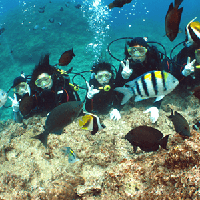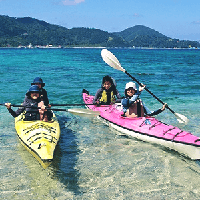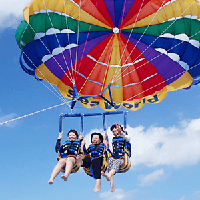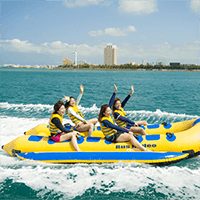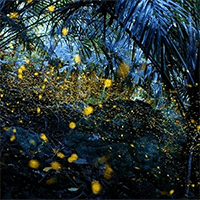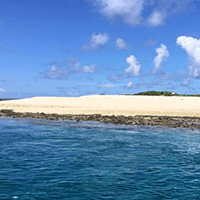List of Dotonbori
- Age 1~Age 70
- Over 6 hours on the day
- 07:20
Schedule for the day: [07:20] Meet at Nihonbashi Exit 2 [09:50] ▼Ine Funaya ~ "The Venice of Japan" "The most beautiful village by the sea" ~ |Ine Town |Funaya Hiyori | INE COFFEE (approx. 40 minutes, walk or ride, ride fare at own expense) [11:10] ▼One of Japan's Three Most Scenic Views, "Amanohashidate Observatory" |Chion-ji Temple / Monjudo Hall (a temple for praying for academic success) |Walking and playing in the sea (approx. 2 hours including lunch, expenses at own expense) [14:40] ▼Kyoto Gassho Village ~ Miyama Kayabuki-no-Sato (approx. 40 minutes, free time) |Let's go to the most beautiful photo spot - the little red post box |Miyama Milk and Miyama Ice Cream are must-try in Miyama [15:20] After a fun day's tour, we headed home. [17:20] Shinsaibashi/Dotonbori Area (about 1 hour, free time) ▼ Funaya Days: Funaya Days is a niche tourist spot in Ine that has been featured in lifestyle magazines recently. Locals with high ideals have been working hard to create a tourist exchange facility where anyone can stop by and enjoy the beautiful scenery of Ine. There are facilities such as an information center, restaurant, and cafe. "Hiyori" means sunny and good weather in Japanese. The sight of the seawater sparkling in the sunlight is the most ideal expression of "Funaya Weather". There is also a boathouse that you can visit. ▼ INE COFFEE: is a Japanese modern design with a focus on simple and clean style. The seaside coffee shop is very attractive, with colorful pillows, and sitting here and looking at the sea is a completely relaxing and healing atmosphere. However, the best view here is from the corner on the first floor. The floor-to-ceiling windows overlook Ine Bay. It's a wonderful view. The "INE CAFE" logo is placed on the table, and two heart-shaped sunglasses are placed on the chair. The cafe basically provides a special area for taking photos and checking in, which is amazing. The beautiful view from the floor-to-ceiling windows is like a postcard, and it makes you feel like time has stopped. You should also visit the unique boathouse - the first floor is a cabin, and the second floor is a private home. This unique structure is a "funaya", a feature unique to Ine Town. This tour is a mixed tour, and participants come from all over the world.
- Age 1~Age 70
- Over 6 hours on the day
- 08:40 / 09:50
[08:40] Exit 2 of Nihonbashi (Namba/Shinsaibashi area) [09:50] Kyoto Station Hachijo Exit, sightseeing bus parking lot [11:20] ▼ One of the Three Scenic Views of Japan, "Amanohashidate Observatory" (about 2.5 hours including lunch, own expense) [14:30] ▼ Ine no Funaya ~ "Venice of Japan" "Kyoto's last hidden place" ~ (about 1 hour, walk or bike, seagull feeding boat, etc., please pay the boarding fee yourself) [15:30] End of the day's tour and head back. [19:00] Shinsaibashi/Dotonbori area (about 1 hour, free time) Amanohashidate is one of the Three Scenic Views of Japan, along with Matsushima in Mutsu and Miyajima in Aki. It is a sandbar about 3.6 kilometers long, formed by the deposition of the coast. About 8,000 pine trees of various sizes are planted, and white sand beaches stretch on both the east and west sides. It is a special natural landscape. It is called "Amanohashidate" because it looks like a bridge stretching diagonally towards the sky. On Mount Monju, there is an observation deck from which you can see Amanohashidate. The mountain has a Ferris wheel and recreational facilities suitable for all ages. From here, Amanohashidate looks like a dragon flying in the sky, so it is called "Flying Dragon View". From here, you can see the vivid scenery of Amanohashidate. (Cable car ticket is at your own expense: Amanohashidate Observation Deck Cable Car/Monorail Combined Ticket 850 yen) [Ine Village] was selected by the Japanese as one of the "18 Most Beautiful Villages in Japan". With its unique Japanese floating boathouse architecture, you can experience the original ecological landscape that you cannot experience in tourist spots. Even today, people coexist with the sea in front of them. The clear and beautiful sea, the deep green mountains, the rapidly changing colors of the sky, and the colors of the boathouses that represent Japan. These are the pure colors of nature that can only be experienced in Ine Town. The fishing village along the coast is away from the hustle and bustle and is full of simple innocence. You can experience a 25-minute cruise around Ine Bay at your own expense, and you can also feed the seagulls. (Boats depart every hour and 30 minutes. The boarding fee is 1,200 yen for adults and 600 yen for children, at your own expense. A bag of food for the seagulls costs 100 yen. If the tour is cancelled due to wind or waves, you can wander around freely.) Note: There are many eagles living around the Ine Funaya Ya, so please be careful when taking the sightseeing boat. If you see an eagle, stop feeding the seagulls immediately and put away any food you are holding to avoid being pecked by the eagle.
- Age 1~Age 70
- Over 6 hours on the day
- 08:40 / 09:50
[08:40] ▼Nihonbashi Station Exit 2 (Namba-Shinsaibashi area) [09:50] ▼Kyoto Station Hachijo Exit (in front of 7-Eleven) [10:30] ▼Kinkaku-ji Temple (about 40 minutes) Visiting fees are at the customer's expense. [12:00] ▼Kiyomizu-dera area (individuals visit, stroll freely, lunch on their own / about 3.5 hours) [15:20] ▼Fushimi Inari Taisha Shrine (about 70 minutes) [16:50] ▼After enjoying the day's itinerary, we start to return. [18:10] ▼Shinsaibashi, Dotonbori area (free stroll / about 1 hour) ▼The original name of Kinkaku-ji Temple is Rokuon-ji Temple. It is also called "Kinkaku-ji Temple" because the exterior walls of the Shariden Hall, the central building of the temple, are all decorated with gold leaf. The temple was built in 1397. Originally a villa for Shogun Ashikaga Yoshimitsu (the prototype of Shogun Yoshimitsu in the anime "Kei Ikkyu-san"), it was later converted into the Zen temple "Bosatsurei". If you visit Kinkaku-ji Temple during the autumn foliage season, the golden tower and the red autumn leaves covering the mountain create a spectacular view. (Admission fee: 500 yen for adults, 300 yen for elementary and junior high school students) ▼ Recommended courses around Kiyomizu-dera Temple Recommended course 1: Kiyomizu-dera Temple (admission fee is at your own expense) - Ninenzaka - Ishibekoji - Gion - Hanamikoji - Yasaka Shrine (You can visit several tourist spots according to your preferences and physical condition) Recommended 2: Kimono experience. Interested guests can wear a kimono, stroll through the old streets, visit Kiyomizu-dera Temple, and leave the most beautiful moments. (There are many kimono shops at Kiyomizu-dera and Fushimi Inari Shrine, and you can choose where to return the kimono. We recommend renting at Kiyomizu-dera and returning at Fushimi Inari. You will be responsible for the cost.) ▼ Fushimi Inari Taisha is famous for its thousand torii gates, and many tourists from both Japan and abroad visit it every year. It was ranked number one for three consecutive years as "Japan's most popular tourist spots for foreigners" in a survey conducted by the world's largest travel site. Let's pray for ourselves and our loved ones here. This is a mixed tour, and participants come from all over the world.
- Age 1~Age 70
- Over 6 hours on the day
- 08:40
〜Schedule〜【07:30-08:30】 ▼Pick up at your hotel or guesthouse, located on the Osaka Loop Line【08:40】 ▼Nihonbashi Station Exit 2 (Namba-Shinsaibashi area)【11:10】 ▼Naruto Whirlpools (approx. 110 mins)【13:40】 ▼Tokushima Awaodori Museum (approx. 90 mins)【16:10】 ▼Awaji Island Happy Pancakes (approx. 90 mins)【17:40】 ▼After enjoying sightseeing for the day, we start to return. 【19:10】 ▼Shinsaibashi, Dotonbori area (free time/approx. 1 hour)The following fees are to be paid by the customer. ①Tide-viewing boat: The ride takes about 30 minutes, and departs once every 40 minutes. Reference price: 1,800 yen for adults, 900 yen for children (7-11 years old). ② Walking trail: 510 yen for adults, 410 yen for junior and senior high school students, 260 yen for elementary school students, free for children under 6 years old. ③ Please pay the participation fee for the Awa Odori dance by yourself. The performance lasts about 40 minutes, and the admission fee is 800 yen for adults and 400 yen for elementary and junior high school students. Closed: December 28th to January 1st, February, June, September, and the second Wednesday of December (the following day if it is a public holiday). This is a mixed tour, and participants come from all over the world.
- Age 1~Age 70
- Over 6 hours on the day
- 08:40 / 09:50
[07:30-08:30] Hotel transfer within the Osaka Loop Line [08:40] Boarding and disembarking at the meeting point, Nihonbashi Station Exit 2 (Namba-Shinsaibashi area) [09:50] Boarding and disembarking at the meeting point, Kyoto Station Hachijo Exit (in front of Seven-Eleven) [10:50] ▼Miho Museum: Pei's Paradise (about 2 hours, free time including lunch, at own expense) (Closed: March 24th, 31st, 2025, April 7th, 14th, 21st, 28th, May 7th, 12th, 19th, 26th, June 2nd, June 9th - July 11th, July 14th, 22nd, 28th, August 4th, 12th, 18th, August 25th - September 19th, September 22nd, 29th, October 6th, 14th, 20th, 27th, November 4th, 10th, 17th, 25th, December 8th, December 15th - 31st) Opening days: Omihachiman Hachimanbori, not Miho Museum ▼Omihachiman Hachimanbori Experience traditional Japanese architecture along the moat A canal tour with atmosphere and history (about 2 hours, including lunch and free time)Miho Museum is closed. Instead of Miho Museum, we will go to Omihachiman Hachimanbori. [13:50] ▼Kyu-Chikurin-in - Reflection like Ruriko-in (about 60 minutes)|▼Hieizan Hiyoshi Taisha - Head shrine of more than 3,800 Hie Shrines, Hiyoshi Shrines, and Sanno Shrines throughout Japan. Monkeys are messengers of the gods. (Approximately 60 minutes, go when the old bamboo forest is closed. Do not enter the old bamboo forest)|Sanno Torii [15:20] ▼Lake Biwa - Shirahige Shrine - Torii in the lake (about 30 minutes) [16:00] ▼After a fun day of sightseeing, we start to head back. [19:00] ▼Shinsaibashi, Dotonbori area (free time / about 1 hour)Guests can play in the Shinsaibashi area of Osaka for about 1 hour. After you're done playing, passengers who have chosen to board and disembark at the meeting point will disband in the Shinsaibashi area. ▼For opening days, please check the Miho Museum official website: http://www.miho.or.jp/calendar/ Permanent exhibition admission fee: 1,100 yen, special exhibition admission ticket: 1,300 yen ▼Ancient bamboo forest admission fee: 330 yen Tasting matcha and Japanese sweets in the garden: 400 yen Closed: Mondays (closed on public holidays), the day after public holidays, December 26th to 31st The Japan tour is a mixed tour, and participants come from all over the world.
- Age 1~Age 70
- Over 6 hours on the day
- 08:40 / 09:50
[08:40] Exit 2 of Nihonbashi (towards Namba-Shinsaibashi) [09:50] Kyoto Station Hachijo Exit, sightseeing bus parking lot [10:30] ▼ Sanzenin Temple (approx. 120 minutes, free time, including lunch, please pay your own expenses) [13:30] ▼ Arashiyama (approx. 3 hours, free time) [16:30] We finished our day's tour with a lot of fun and headed home. [17:50] Shinsaibashi/Dotonbori area (approx. 1 hour, free time) Recommended restaurants near Sanzenin Temple: Keibisakan mainly serves soba, tofu dishes, and creative cuisine. Ippukuchaya Main menu: Udon, soba, bowls Ryokawachaya Main menu: Udon, yuba dishes Shinomatsumon mainly serves Kyoto cuisine, tofu dishes, and yuba dishes. Recommended route in Arashiyama (at your own expense. We recommend you choose a tour)1. Sagano train (recommended route: Sagano - Kameoka Station - Sagano)Travel period: March 1st to December 29th (trains do not operate in January and February due to winter maintenance)Closed: Wednesdays (train ticket price is not included, must be purchased separately)Cherry blossom season and autumn leaves season (Arashiyama train, operation date undecided) 1 train 30 seats2. Sagano Bamboo Forest PathSagano Bamboo Forest is located in Arashiyama. The bamboo forest path is about 500 meters long. Pass Nonomiya Shrine and head towards Okawachi Sanso to reach the Arashiyama Bamboo Forest. Walking through the bamboo forest, you can hear the natural sound of the wind blowing through the bamboo leaves. This sound has also been selected as one of the "100 Sounds of Japan that Should Be Preserved". This is also where Ang Lee shot Crouching Tiger, Hidden Dragon. Tenryu-ji Temple on the trail offers a spectacular view of a Japanese garden. The Arashiyama Lantern Festival, held every December, illuminates the bamboo forest and Togetsukyo Bridge with dazzling lights, creating a wintery sight. This is a shared tour, and participants come from all over the world.
- Age 1~Age 70
- Over 6 hours on the day
- 08:40 / 09:50
[08:40] ▼Nihonbashi Station, Exit 2 (Namba-Shinsaibashi area) [09:50] ▼Kyoto Station, Hachijo Exit (in front of 7-Eleven) [10:00] ▼Kiyomizu-dera area (individuals can visit the shrine, stroll around freely, and have lunch at their leisure / approx. 3 hours) [13:30] ▼Fushimi Inari Taisha Shrine (individuals can visit the shrine, stroll around freely / approx. 70 minutes) [15:30] ▼Nara Park (individuals can visit the shrine, stroll around freely / approx. 1.5 hours) [17:00] ▼After a fun day's sightseeing, we start to head back. [18:00] ▼Shinsaibashi, Dotonbori area (free time/about 1 hour) Recommended sightseeing course Course 1: Kiyomizu-dera Temple (customer pays admission fee) -Ninen-zaka -Ishibekoji -Gion·Hanamikoji-dori -Yasaka Shrine You can visit your favorite spots according to your physical strength and time~Course 2: Kimono experience (Customers who are interested can wear a kimono and enjoy the old townscape and touring Kiyomizu-dera Temple. Let's take pictures of the wonderful moment.) (There are many kimono shops near Kiyomizu-dera Temple and Fushimi Inari Taisha Shrine. We recommend renting a kimono at a shop in Kiyomizu-dera Temple and returning it at a shop in Fushimi Inari Taisha Shrine. Customers are responsible for the fee.) Course 3: "Nara Park" where "deer and autumn leaves" are woven together The contrast between the autumn leaves and evergreen trees is vivid Course 4: Todai-ji Temple (customer pays admission fee) Todai-ji Temple was built in the Nara period. Nara is popular with tourists and once served as the capital of Japan. It is registered as a UNESCO World Heritage Site as one of the "Historic Monuments of Ancient Nara". Todaiji Temple has eight national treasure buildings, 14 buildings with 24 national treasure Buddhas, and nine other national treasures such as paintings and books. The famous Great Buddha, the Great South Gate, the Kongorikishi standing statues, and the Hokke-do Hall, as well as the Buddha statues enshrined therein, are all national treasures. There are few places in Japan where you can see so many national treasures at once. Admission fees: Todaiji Great Buddha Hall: Adults (junior high school students and above) 600 yen, elementary school students 300 yen; Great Buddha Hall and Todaiji Museum: Adults (junior high school students and above) 1000 yen, elementary school students 400 yen This is a mixed tour, and participants will come from all over the world.
- Age 1~Age 70
- Over 6 hours on the day
- 10:30 / 11:30
〜Schedule〜(Note: Winter time: 10/16-5/14. Summer time: 5/15-10/15)1. Winter time [09:30-10:30] ▼Pick up/drop off/drop off at hotel/private inn, hotel/private inn on Osaka Loop Line [10:30] ▼Nihonbashi Station Exit 2 (Namba-Shinsaibashi area) [12:00] ▼Kobe-Sanda Premium Outlets (free walk/lunch on your own/about 4 hours; not going to Kitano Ijinkan-gai and Kobe Port) [16:30] ▼Arima Onsen (about 1.5 hours, free time) [18:00] ▼Night view of Mt. Rokko (about 1.5 hours, cable car fare at your own expense)If the cable car is not in operation due to weather or other force majeure, the bathing time in Arima Onsen will be extended. [19:30] ▼The tour ends at a hotel in the Shinsaibashi/Dotonbori area or Osaka city. 【20:30】 ▼Disband at the meeting pointDisband 2, Summer time【10:30-11:30】 ▼Pick up/drop off/pick up at hotel/private inn, hotel/private inn on Osaka Loop Line【11:30】▼Nihonbashi Station Exit 2 (Namba-Shinsaibashi area)【13:00】▼Kobe-Sanda Premium Outlets (free walk/lunch on your own/about 4 hours; not going to Kitano Ijinkan-gai and Kobe Port)【17:30】 ▼Arima Onsen (about 1.5 hours, free time)【19:00】 ▼Night view of Mt. Rokko (about 1.5 hours, cable car fare at own expense)If the cable car is suspended due to weather or other force majeure, the bathing time in Arima Onsen will be extended. 【20:30】 ▼The tour ends at a hotel in the Shinsaibashi/Dotonbori area or Osaka city. [21:30] ▼Disband at the meeting point▼ Kobe Mita Outlet Operated by the famous American outlet group Chelsea, it is built in the style of Pasadena, a high-end residential area on the outskirts of Los Angeles. It is an outlet that sells mid-to-high-end products. Mita Outlet boasts a beautiful environment and convenient transportation. There are about 180 famous domestic and international brand stores selling fashion apparel, clothing and miscellaneous goods, sports goods, interior goods, etc. The brands range from high-end luxury brands to affordable luxury brands, such as Anna Sui, Folli Follie, Furla, Abahouse, Balenciaga, Bottega Veneta, Chloe, Givenchy, Gap, Issey Miyake, etc. Children will not be bored even if they come here. There is also a Lego store inside the outlet. While parents are shopping, children can also buy the toys they want. *Tourists can exchange passports and coupons at the information center. There is also an AEON Mall next to Mita Outlet, which has many restaurant and shopping options. This is a shared tour and participants come from all over the world.
- Age 1~Age 70
- Over 6 hours on the day
- 08:40 / 09:50
[08:40] ▼ Departure from National Cultural Theater [09:50] ▼ Departure from Kyoto Station Hachijo Exit [10:10] ▼ Kiyomizu-dera area (approx. 180 minutes, free tour, please pay your own admission fee) Kiyomizu-dera | Nijozaka [13:30] ▼ Fushimi Inari Taisha (approx. 70 minutes, free time) [15:10] ▼ Uji (approx. 90 minutes, free time) Byodo-in | Tale of Genji Museum | Uji Matcha Old Shop [16:40] ▼ After a fun day of tour, we headed back home. [18:00] ▼ Arrived in Shinsaibashi/Dotonbori area, tour ended ▼ Kiyomizu-dera National Treasure World Heritage Site World Cultural Heritage Site and popular tourist spot in Kyoto. Founded in 778, it is the oldest temple in Kyoto and a national treasure of Japan. Kiyomizu-dera Temple offers different views in each season. In spring, attractive cherry blossoms bloom among the green leaves. In summer, it is lush with greenery. In autumn, you can see colorful autumn leaves. In winter, the beautiful trees are in full bloom. Any time is ideal to visit. Kiyomizu-dera also holds light-up events in spring and autumn to show off the beauty of the temple. (Admission fee: 400 yen for adults, 200 yen for elementary and junior high school students) Please pay by yourself. ▼ A typical Kyoto landscape, a symbol of quiet Kyoto, take photos and check in at Nijozaka and Yasaka Pagoda Hokan-ji is a temple of the Kennin-ji school of the Rinzai sect of Buddhism located in Higashiyama Ward, Kyoto City, Kyoto Prefecture. This mountain is called "Reitaka Mountain". The main image is Yakushi Nyorai, and there is a legend that the founder was Prince Shotoku. The five-story pagoda is commonly known as "Yasaka Pagoda" and is a symbol of Higashiyama. ▼ Fushimi Inari Taisha is famous for its thousand torii gates, and many tourists from Japan and abroad visit it every year. In a survey conducted by the world's largest travel site, it has been ranked first for three consecutive years in "Japan's most popular tourist spots for foreigners". Let us pray for ourselves and our loved ones here. The votive plaques at Fushimi Inari Taisha are also unique. They are in the shape of a white fox, and you can doodle them with various expressions depending on your imagination. ▼Uji For matcha lovers, Uji is a gourmet paradise. The streets are filled with the finest matcha ice cream and cakes, and even the soba noodles are green matcha green. For literature lovers, it is an art paradise, as the last ten chapters of The Tale of Genji, a literary masterpiece known as Dream of the Red Chamber in Japan, are set in Uji. Anyone who has read The Tale of Genji will want to come here to follow the love, hate, and revenge of Japanese aristocrats. This is a shared tour and participants come from all over the world.
- Age 1~Age 70
- Over 6 hours on the day
- 08:40
[08:40] ▼ Exit 2 of Nihonbashi (Namba/Shinsaibashi area) [10:00] ▼ Nara Park area Spring wonderland of cute deer and cherry blossoms (about 2 hours including lunch and free time) ▼ World Heritage Todaiji Temple (entrance fee at own expense) [14:00] ▼ Cherry blossom viewing at Mt. Yoshino ~ A dreamlike spring day in a sea of 30,000 cherry blossoms ~ (about 3 hours, free time) [17:00] ▼ We finished the day's tour and headed home. [18:30] ▼ Recommended lunch in the Shinsaibashi/Dotonbori area (please pay at your own expense) Kasugano is a long-established deer restaurant founded in 1936, located in the shopping district in front of Mt. Wakakusa. You can dine while watching the deer running around. We offer dishes that change with the seasons so that you can feel the nature of Mt. Wakakusa. Address: 494 Zojirushi-cho, Nara City Kasuga Chaya Kasuga Chaya is run by Kasuga Taisha, a famous tourist attraction in Nara. In a hidden place surrounded by Kasuga Taisha and deer, you can taste traditional Japanese cuisine. The most famous dish at the chaya is "Manyo Congee". Manyo Congee is made from different plants in each season, so the taste varies depending on the month. Not only is it delicious, but it also has a little random fun. It is the best choice to refuel after visiting Kasuga Taisha. Travelers who like to try new things should not miss it. Address: 160 Kasugano-cho, Nara City, Nara Prefecture Noodle House Udon is a national dish in the Kansai region. "Mentani-an" in the Nara shopping district is also one of the most popular restaurants in Nara, where you can often find a line. The most popular is "Gold Leaf Udon", which is udon wrapped in yuba, and the "Small Deka Udon" with a deer pattern is unique to the Nara region and is very popular with the common people. Address: 30-1 Hashimotocho, Nara City, Nara PrefectureThis is a mixed tour and participants come from all over the world.
- Age 1~Age 70
- Over 6 hours on the day
- 08:40
[07:30-08:30] ▼Address within the Osaka Loop Line (Pickup and drop-off from hotels in the city) [08:40] ▼Nihonbashi Station, Exit 2 (Board and disembark at the meeting point) [10:10] ▼Popular cat stationmaster--Kishi Station (approx. 60 minutes) [12:40] ▼Shirahama Toretore Market---One of the largest seafood markets in western Japan (Free stroll and free lunch / approx. 120 minutes, food costs at customer's expense.) [14:55] ▼Senjojiki (approx. 30 minutes) | ▼Sandanbeki - Sandanbeki Cave deep below the cliff A spectacular journey through precipitous cliffs and stirring human emotions (approx. 30 minutes) [16:00] ▼After an enjoyable end to sightseeing for the day, we start to head back. [18:30] ▼Shinsaibashi, Dotonbori area (free time/about 1 hour) Guests can play in the Shinsaibashi area of Osaka for about an hour. Once you're done playing, the tour ends in the Shinsaibashi area. Guests who don't want to play can disband directly in the Shinsaibashi area. ▼Senjojiki Senjojiki is a unique landscape located on the west coast of Shirahama City, Wakayama Prefecture. The sandstone geology has been eroded by the Pacific Ocean over the years, forming a complex topography with overlapping layers. From a distance, it looks like many rock plates are piled up. The total area of this coastline is about 4 hectares, and it is so large that it is a thousand tatami mats (Japanese people have the habit of using the size of a tatami mat, "tatami" to measure area), so it was named "Senjofu". Along with Sandanbeki and Engetsuto Island, it is a scenic spot in Shirahama. Senjojiki is a famous sunset spot that locals are proud of. If the weather is good, you can see the sun slowly sinking into the Pacific Ocean. This beautiful scenery has also been selected as one of the "Top 100 Sunsets in Japan." Its remote location, unique rugged terrain, and the waves of the Pacific Ocean combine to make watching the sunset here feel like you're at the edge of the world. ▼▼Sandanbeki - Sandanbeki Cave Deep in the Cliffs Magnificent Cliffs and an Exciting Past Sandanbeki is part of Kumano National Park, a famous scenic spot in Shirahama, and a lovers' sanctuary. Sandanbeki is a famous cliff scenic spot located on the coast of Shirahama-cho, Nishimuro-gun, Wakayama Prefecture. Sandanbeki is actually a large underwater rock wall that is 2 kilometers long and 50 to 60 meters high. There is an observation deck on top of the cliff, where you can enjoy the view of the Nanki sea. The cliffs here not only have amazing natural scenery, but various historical events have been unfolding below the cliffs for centuries. (During the Heian period (794-1185), local pirates who plundered the area hid in the Sandanbeki caves.) A ticket is required for admission. Tickets are at your own expense. Reference ticket prices: Adults: 1500 yen, Children aged 6-11: 750 yen, Children under 6 years old: Free. This is a shared tour, and participants come from all over the world.
最近チェックしたプラン
Please wait a moment
![[Amanohashidate] Amanohashidate | Amanohashidate Observatory | Ine Funaya | Miyama Gassho Village Thatched Roof Village Day Tour | Departing from Osakaの画像](https://img.activityjapan.com/10/56281/10000005628101_KGckTMmm_3.jpg?version=1730786645)
![[Day Trip] Amanohashidate, Chionji Temple, Monjudo, and Ine Funaya Day Trip (Departing from Kyoto/Osaka)の画像](https://img.activityjapan.com/10/55399/10000005539901_P3BiVCAd_3.jpg?version=1729051142)
![[Day trip | Pick-up from city hotels] Ancient Kyoto Japanese-style tour: Kinkaku-ji Temple - Kiyomizu-dera Temple - Fushimi Inari Taisha Shrineの画像](https://img.activityjapan.com/10/55487/10000005548701_P3BiVCAd_3.jpg?version=1733822342)
![[Day trip/Pick-up from city hotels] Awaji Island/Naruto Whirlpools | Tokushima Awaodori Hall | Awaji Island Happy Pancake Net Celebrity Vacation Day Trip Tourの画像](https://img.activityjapan.com/10/55719/10000005571901_1dhWswak_3.jpg?version=1744856222)
![[Day trip/Pick-up from city hotels] Miho Museum | Omihachiman | Former Bamboo Forest Garden | Hieizan Hiyoshi Taisha Shrine | Lake Biwa | Water Torii of Shirasu Shrineの画像](https://img.activityjapan.com/10/55718/10000005571801_1dhWswak_3.jpg?version=1744171925)
![[Day trip/Pick-up from city hotels] Kyoto, Arashiyama trolley train, Sanzen-in Templeの画像](https://img.activityjapan.com/10/55488/10000005548801_P3BiVCAd_3.jpg?version=1744016286)
![[Day Trip] Kyoto, Nara, Kiyomizu-dera Temple, Kimono Experience, Yasaka Shrine, Fushimi Inari Taisha Shrine, Nara Park, Todaiji Temple Day Trip (Departing from Osaka/Kyoto)の画像](https://img.activityjapan.com/10/55460/10000005546001_P3BiVCAd_3.jpg?version=1730786226)
![[Day trip/Pick-up from city hotels] Kobe night view | Mita Outlet | Arima Onsen | Rokko Mountain night view | Rokko Mountain Sky Observatoryの画像](https://img.activityjapan.com/10/55492/10000005549201_P3BiVCAd_3.jpg?version=1744699982)
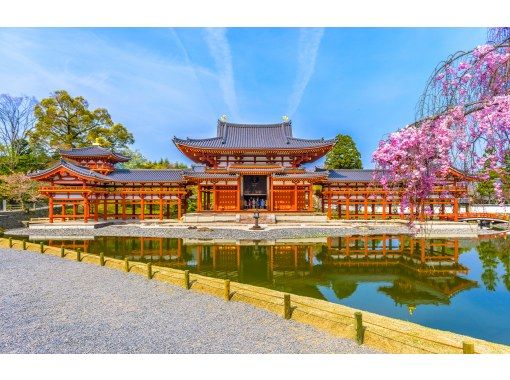
![[Cherry Blossom Season Only] Cute Deer in Nara Park | Todaiji Temple | Cherry Blossom Viewing at Mt. Yoshino | Senbonzakura | Free Cherry Blossom Bell | 1-Day Tourの画像](https://img.activityjapan.com/10/58252/10000005825201_wXgQnW2u_3.jpg?version=1741679646)
![[Day trip/Pick-up from city hotels] Nanki Shirahama Onsen/Popular cat stationmaster -- Kishi Station/Senjojikiの画像](https://img.activityjapan.com/10/55508/10000005550801_1dhWswak_3.jpg?version=1744169825)

